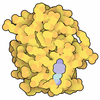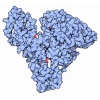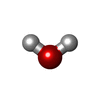[English] 日本語
 Yorodumi
Yorodumi- PDB-9o45: Crystal structure of the L411W mutant of pregnane X receptor liga... -
+ Open data
Open data
- Basic information
Basic information
| Entry | Database: PDB / ID: 9o45 | ||||||
|---|---|---|---|---|---|---|---|
| Title | Crystal structure of the L411W mutant of pregnane X receptor ligand binding domain in complex with SJPYT-328 | ||||||
 Components Components | Pregnane X receptor ligand binding domain tethered to steroid receptor coactivator-1 peptide | ||||||
 Keywords Keywords | TRANSCRIPTION / Pregnane X receptor / PXR / NR1I2 / transcription factor / nuclear receptor / drug metabolism | ||||||
| Function / homology |  Function and homology information Function and homology informationcellular response to molecule of bacterial origin / intestinal epithelial structure maintenance / intermediate filament cytoskeleton / labyrinthine layer morphogenesis / positive regulation of transcription from RNA polymerase II promoter by galactose / regulation of thyroid hormone receptor signaling pathway / positive regulation of female receptivity / xenobiotic transport / NR1H2 & NR1H3 regulate gene expression to control bile acid homeostasis / male mating behavior ...cellular response to molecule of bacterial origin / intestinal epithelial structure maintenance / intermediate filament cytoskeleton / labyrinthine layer morphogenesis / positive regulation of transcription from RNA polymerase II promoter by galactose / regulation of thyroid hormone receptor signaling pathway / positive regulation of female receptivity / xenobiotic transport / NR1H2 & NR1H3 regulate gene expression to control bile acid homeostasis / male mating behavior / hypothalamus development / steroid metabolic process / cellular response to Thyroglobulin triiodothyronine / Synthesis of bile acids and bile salts / progesterone receptor signaling pathway / Synthesis of bile acids and bile salts via 27-hydroxycholesterol / Endogenous sterols / Synthesis of bile acids and bile salts via 7alpha-hydroxycholesterol / response to retinoic acid / xenobiotic catabolic process / estrous cycle / nuclear retinoid X receptor binding / histone acetyltransferase activity / cellular response to hormone stimulus / Recycling of bile acids and salts / Transcriptional regulation of brown and beige adipocyte differentiation by EBF2 / histone acetyltransferase / NR1H3 & NR1H2 regulate gene expression linked to cholesterol transport and efflux / intracellular receptor signaling pathway / estrogen receptor signaling pathway / lactation / : / positive regulation of adipose tissue development / Regulation of lipid metabolism by PPARalpha / peroxisome proliferator activated receptor signaling pathway / positive regulation of neuron differentiation / regulation of cellular response to insulin stimulus / xenobiotic metabolic process / BMAL1:CLOCK,NPAS2 activates circadian expression / SUMOylation of transcription cofactors / Activation of gene expression by SREBF (SREBP) / response to progesterone / cerebellum development / nuclear estrogen receptor binding / nuclear receptor binding / RNA polymerase II transcription regulatory region sequence-specific DNA binding / hippocampus development / SUMOylation of intracellular receptors / mRNA transcription by RNA polymerase II / Heme signaling / Transcriptional activation of mitochondrial biogenesis / PPARA activates gene expression / Cytoprotection by HMOX1 / cerebral cortex development / Nuclear Receptor transcription pathway / Transcriptional regulation of white adipocyte differentiation / RNA polymerase II transcription regulator complex / male gonad development / nuclear receptor activity / sequence-specific double-stranded DNA binding / : / response to estradiol / HATs acetylate histones / MLL4 and MLL3 complexes regulate expression of PPARG target genes in adipogenesis and hepatic steatosis / DNA-binding transcription activator activity, RNA polymerase II-specific / transcription regulator complex / Estrogen-dependent gene expression / DNA-binding transcription factor activity, RNA polymerase II-specific / cell differentiation / transcription coactivator activity / protein dimerization activity / nuclear body / positive regulation of apoptotic process / RNA polymerase II cis-regulatory region sequence-specific DNA binding / negative regulation of DNA-templated transcription / chromatin binding / positive regulation of gene expression / regulation of DNA-templated transcription / chromatin / positive regulation of DNA-templated transcription / protein-containing complex binding / negative regulation of transcription by RNA polymerase II / signal transduction / positive regulation of transcription by RNA polymerase II / protein-containing complex / zinc ion binding / nucleoplasm / nucleus / plasma membrane / cytosol Similarity search - Function | ||||||
| Biological species |  Homo sapiens (human) Homo sapiens (human) | ||||||
| Method |  X-RAY DIFFRACTION / X-RAY DIFFRACTION /  SYNCHROTRON / SYNCHROTRON /  MOLECULAR REPLACEMENT / Resolution: 2.56 Å MOLECULAR REPLACEMENT / Resolution: 2.56 Å | ||||||
 Authors Authors | Huber, A.D. / Garcia-Maldonado, E. / Miller, D.J. / Chen, T. | ||||||
| Funding support |  United States, 1items United States, 1items
| ||||||
 Citation Citation |  Journal: Structure / Year: 2025 Journal: Structure / Year: 2025Title: Subtle changes in ligand-receptor interactions dramatically alter transcriptional outcomes of pregnane X receptor modulators. Authors: Huber, A.D. / Garcia-Maldonado, E. / Lin, W. / Poudel, S. / Wu, J. / Miller, D.J. / Chen, T. | ||||||
| History |
|
- Structure visualization
Structure visualization
| Structure viewer | Molecule:  Molmil Molmil Jmol/JSmol Jmol/JSmol |
|---|
- Downloads & links
Downloads & links
- Download
Download
| PDBx/mmCIF format |  9o45.cif.gz 9o45.cif.gz | 144.1 KB | Display |  PDBx/mmCIF format PDBx/mmCIF format |
|---|---|---|---|---|
| PDB format |  pdb9o45.ent.gz pdb9o45.ent.gz | 100.8 KB | Display |  PDB format PDB format |
| PDBx/mmJSON format |  9o45.json.gz 9o45.json.gz | Tree view |  PDBx/mmJSON format PDBx/mmJSON format | |
| Others |  Other downloads Other downloads |
-Validation report
| Summary document |  9o45_validation.pdf.gz 9o45_validation.pdf.gz | 908.1 KB | Display |  wwPDB validaton report wwPDB validaton report |
|---|---|---|---|---|
| Full document |  9o45_full_validation.pdf.gz 9o45_full_validation.pdf.gz | 914 KB | Display | |
| Data in XML |  9o45_validation.xml.gz 9o45_validation.xml.gz | 25.6 KB | Display | |
| Data in CIF |  9o45_validation.cif.gz 9o45_validation.cif.gz | 32.7 KB | Display | |
| Arichive directory |  https://data.pdbj.org/pub/pdb/validation_reports/o4/9o45 https://data.pdbj.org/pub/pdb/validation_reports/o4/9o45 ftp://data.pdbj.org/pub/pdb/validation_reports/o4/9o45 ftp://data.pdbj.org/pub/pdb/validation_reports/o4/9o45 | HTTPS FTP |
-Related structure data
| Related structure data |  9o41C  9o42C  9o43C  9o44C  9o46C C: citing same article ( |
|---|---|
| Similar structure data | Similarity search - Function & homology  F&H Search F&H Search |
- Links
Links
- Assembly
Assembly
| Deposited unit | 
| ||||||||||||
|---|---|---|---|---|---|---|---|---|---|---|---|---|---|
| 1 |
| ||||||||||||
| Unit cell |
|
- Components
Components
| #1: Protein | Mass: 40415.297 Da / Num. of mol.: 2 / Mutation: L411W Source method: isolated from a genetically manipulated source Source: (gene. exp.)  Homo sapiens (human) / Gene: NR1I2, PXR, NCOA1, BHLHE74, SRC1 / Production host: Homo sapiens (human) / Gene: NR1I2, PXR, NCOA1, BHLHE74, SRC1 / Production host:  References: UniProt: O75469, UniProt: Q15788, histone acetyltransferase #2: Chemical | Mass: 508.652 Da / Num. of mol.: 2 / Source method: obtained synthetically / Formula: C29H40N4O4 / Feature type: SUBJECT OF INVESTIGATION #3: Water | ChemComp-HOH / | Has ligand of interest | Y | Has protein modification | N | |
|---|
-Experimental details
-Experiment
| Experiment | Method:  X-RAY DIFFRACTION / Number of used crystals: 1 X-RAY DIFFRACTION / Number of used crystals: 1 |
|---|
- Sample preparation
Sample preparation
| Crystal | Density Matthews: 2.47 Å3/Da / Density % sol: 50.3 % |
|---|---|
| Crystal grow | Temperature: 293 K / Method: vapor diffusion, hanging drop Details: 50 mM Bis-Tris (pH 6-7), 9-16% (v/v) 2-methyl-2,4-pentanediol PH range: 6-7 |
-Data collection
| Diffraction | Mean temperature: 100 K / Serial crystal experiment: N |
|---|---|
| Diffraction source | Source:  SYNCHROTRON / Site: SYNCHROTRON / Site:  NSLS-II NSLS-II  / Beamline: 17-ID-1 / Wavelength: 0.9201 Å / Beamline: 17-ID-1 / Wavelength: 0.9201 Å |
| Detector | Type: DECTRIS EIGER X 9M / Detector: PIXEL / Date: Jun 3, 2024 |
| Radiation | Protocol: SINGLE WAVELENGTH / Monochromatic (M) / Laue (L): M / Scattering type: x-ray |
| Radiation wavelength | Wavelength: 0.9201 Å / Relative weight: 1 |
| Reflection | Resolution: 2.56→45.18 Å / Num. obs: 26319 / % possible obs: 99.9 % / Redundancy: 7.4 % / Biso Wilson estimate: 61.23 Å2 / CC1/2: 0.997 / Rsym value: 0.097 / Net I/σ(I): 11 |
| Reflection shell | Resolution: 2.56→2.67 Å / Redundancy: 7.7 % / Mean I/σ(I) obs: 2.2 / Num. unique obs: 3134 / CC1/2: 0.769 / Rsym value: 0.863 / % possible all: 99.1 |
- Processing
Processing
| Software |
| ||||||||||||||||||||||||||||||||||||||||||||||||||||||||||||||||||||||||||||||||||||
|---|---|---|---|---|---|---|---|---|---|---|---|---|---|---|---|---|---|---|---|---|---|---|---|---|---|---|---|---|---|---|---|---|---|---|---|---|---|---|---|---|---|---|---|---|---|---|---|---|---|---|---|---|---|---|---|---|---|---|---|---|---|---|---|---|---|---|---|---|---|---|---|---|---|---|---|---|---|---|---|---|---|---|---|---|---|
| Refinement | Method to determine structure:  MOLECULAR REPLACEMENT / Resolution: 2.56→45.18 Å / SU ML: 0.3235 / Cross valid method: FREE R-VALUE / σ(F): 1.34 / Phase error: 26.4353 MOLECULAR REPLACEMENT / Resolution: 2.56→45.18 Å / SU ML: 0.3235 / Cross valid method: FREE R-VALUE / σ(F): 1.34 / Phase error: 26.4353 Stereochemistry target values: GeoStd + Monomer Library + CDL v1.2
| ||||||||||||||||||||||||||||||||||||||||||||||||||||||||||||||||||||||||||||||||||||
| Solvent computation | Shrinkage radii: 0.9 Å / VDW probe radii: 1.1 Å / Solvent model: FLAT BULK SOLVENT MODEL | ||||||||||||||||||||||||||||||||||||||||||||||||||||||||||||||||||||||||||||||||||||
| Displacement parameters | Biso mean: 71.42 Å2 | ||||||||||||||||||||||||||||||||||||||||||||||||||||||||||||||||||||||||||||||||||||
| Refinement step | Cycle: LAST / Resolution: 2.56→45.18 Å
| ||||||||||||||||||||||||||||||||||||||||||||||||||||||||||||||||||||||||||||||||||||
| Refine LS restraints |
| ||||||||||||||||||||||||||||||||||||||||||||||||||||||||||||||||||||||||||||||||||||
| LS refinement shell |
|
 Movie
Movie Controller
Controller


 PDBj
PDBj












